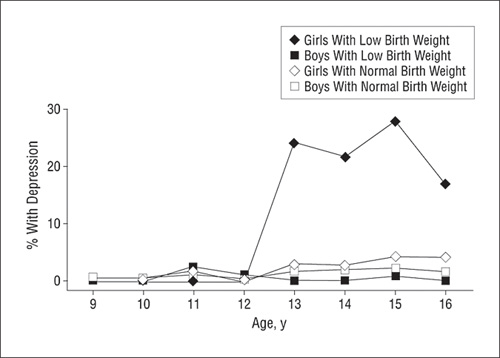Archived Content
The National Institute of Mental Health archives materials that are over 4 years old and no longer being updated. The content on this page is provided for historical reference purposes only and may not reflect current knowledge or information.
Depression Risk Higher in Girls with Low Birth Weight
• Science Update
Girls’ risk for developing depression after puberty increased significantly if they had low birth weight, in a study funded in part by NIMH. Yet low birth weight didn’t appear to be just one more risk factor for depression. Rather, it seemed to increase the risk effects of other adversities.
Among the 5.7 percent of girls in the study with low birth weight, more than 38 percent developed at least one episode of depression as teens, compared to only 8.4 percent with normal birth weight.
If a teenage girl with low birth weight had just one other risk factor — such as teenage pregnancy or sexual abuse — her odds of developing depression increased to 19.6 percent versus 3.6 percent for normal birth weight girls. If she had two more risk factors, the risk rose to 68.5 percent versus 19.7 percent for normal birth weight girls. But if she had no other risk factors, low birth weight posed no additional risk. Nor did it increase depression risk in teenage boys.
The findings suggest that adaptations in the womb that optimize survival under adverse conditions that can lead to low birth weight may later impair girls’ ability to cope with stress. Their lower thresholds for stress-triggered illness may remain latent until they “encounter adversities that strain their capacity,” suggest Drs. Elizabeth Jane Costello, Adrian Angold, Duke University, and colleagues, in the March 2007 Archives of General Psychiatry.
The researchers drew on assessments of depression in 1,420 North Carolina boys and girls, ages 9-16, during the l990s, relying on mothers’ recollections of birth weights and other risk factors.
“Low birth weight predicted depression, only in adolescence and only in girls,” even after other depression-related adversities — such as living in a dangerous neighborhood, having single or mentally ill parents, or poor health — were factored into the analysis, report the researchers.
Even though boys are more prone to low birth weight, fewer than five percent of low birth weight teenage boys became depressed — about the same rate as other boys. The researchers note that boys appear to be more prone to early developmental insults and have higher rates of early-onset disorders like ADHD and autism, while girls seem more prone to later-onset disorders like depression.
Social phobia, post-traumatic stress disorder and generalized anxiety disorders were three times higher in girls with low birth weight than in boys or girls with normal birth weight. However, evidence suggested that this was likely a reflection of the fact that these disorders co-occurred with depression.
“The findings suggest that pediatricians and parents of girls who were of low birth weight should pay close attention to their mental health as they enter puberty,” suggest the researchers.

Girls with low birth weight showed much higher rates of depression after puberty than boys with low birth weight or girls with normal birth weight. Chart shows three-month prevalence of depression.
Source: Duke University Medical School, Center for Developmental Epidemiology, Department of Psychiatry and Behavioral Sciences
